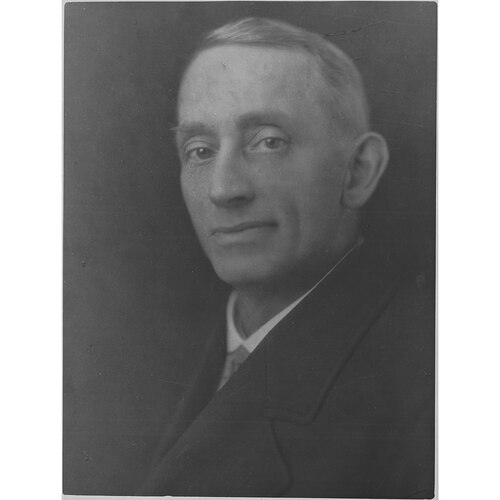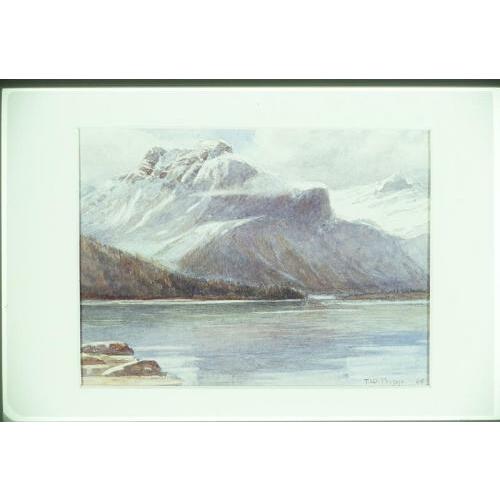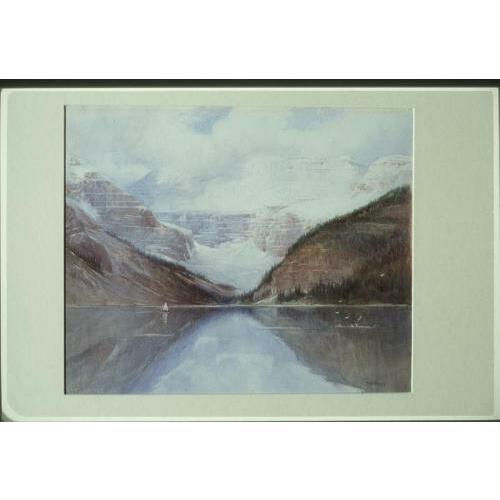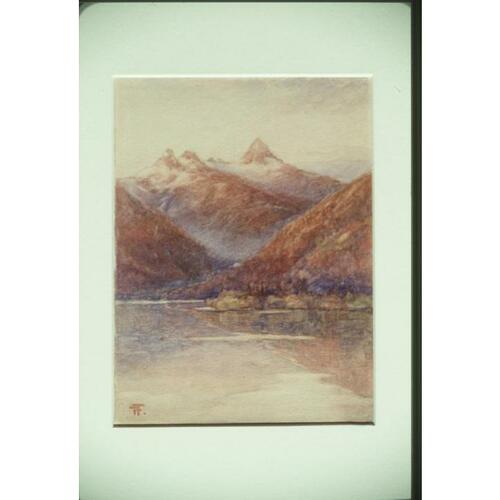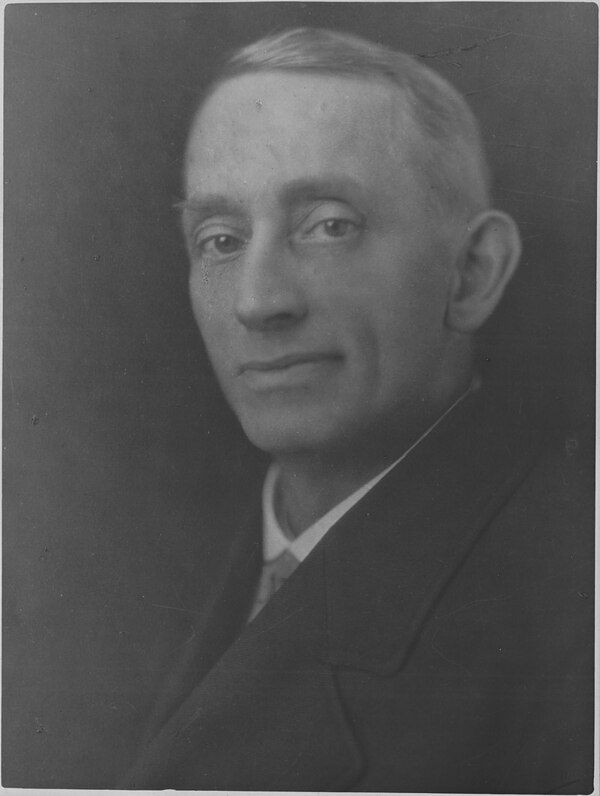
Source: Link
FRIPP, THOMAS WILLIAM, painter and photographer; b. 23 March 1864 in St John’s Wood, London, England, son of George Arthur Fripp, a landscape artist, and Mary Percival; m. 9 June 1897 Gertrude Maude Muriel (d. 1952) in Vancouver, and they had two sons and a daughter; d. there 30 May 1931.
Before his arrival in Canada, Thomas William Fripp, one of 12 children, had followed in his father’s path and pursued artistic training. He attended St John’s Wood School of Art in the early 1880s and spent the year 1886 studying in Italy. After his return to England, he completed his formal education, working under the guidance of his father from 1887 to 1889 at the Royal Academy of Arts. There he mastered the 19th-century tradition of watercolours that rendered landscapes with both perspective and atmosphere. It is not certain what occupations he held in the following years, but it is known that he travelled extensively.
When Fripp arrived in British Columbia in 1893, he settled in Hatzic to pursue life as a homesteader. One brother, Charles Edwin, had lived there for some time and another, Robert Mackay, had established an architectural practice in Vancouver in 1888. After a number of years Thomas William, who had suffered an injury, abandoned farming and moved to Vancouver to rekindle his painting career. Between 1900 and 1902 he supported himself and his family by working in a local photographic studio.
Fripp’s first reported exhibition of paintings in Canada was with the Vancouver Arts and Crafts Association in 1900. Between 1903 and 1908 he exhibited at James Jerris Blomfield’s studio and with the Studio Club. Although his canvas Gladys won a gold medal for portraiture in Winnipeg in 1905, he had difficulty making a living from his creative work; other artists in Vancouver had similar problems. Critics of an exhibition held at Blomfield’s studio in 1904 had commented on the public’s apathy towards the visual arts. In order to attract attention and bring together artists and those interested in their work, Fripp, along with Emily Carr* and others in the area, set up the British Columbia Society of Fine Arts. In 1909 it became the first chartered art society in the province. Fripp served as its founding president and remained in office for seven years.
At the time that the BCSFA was formed, Fripp was considered to be the leading painter in British Columbia and was able to live from his sales, one of the first artists in Vancouver to do so. In the early 20th century the predilection of the city’s small art audience for watercolours of landscapes and for realistic representation allowed him to remain in high standing in art circles. He would routinely exhibit with the BCSFA, beginning with its initial show and continuing until his retirement. Fripp also displayed his paintings with the Island Arts and Crafts Society in Victoria during the years 1912–14 and 1928–30.
In the 1920s Fripp continued to play a leadership role. He served as president of the Vancouver Sketch Club in 1920–21. In 1920 he became a member of the first executive committee of the British Columbia Art League, created to found an art school in Vancouver; this goal would be realized in 1925. In 1924, as a member of the BCFSA, he was instrumental in directing a strong complaint to the Canadian selection committee for the British Empire exhibitions of 1924 and 1925; he chastised it for submitting 120 artworks from eastern Canada and only 5 from the west. During his second tenure as president of the BCSFA (1926–31), he criticized the National Gallery of Canada for slighting the west. At its first annual exhibition of Canadian art in 1926 not a single artist from Vancouver had been included, and from 1927 to 1929 only artists who had recently moved to the west coast, such as Charles Hepburn Scott and Frederick Horsman Varley*, had been represented. Fripp stated in 1930 that the gallery did not know of a Canada outside of Montreal, Ottawa, and Toronto. As a result of his efforts to promote the province’s artists, the gallery made Varley, Scott, and Fripp responsible for choosing works from British Columbia for the annual exhibition of 1931.
Throughout Fripp’s 30-year-long artistic career in Canada, his style remained remarkably unchanged. The wash of colour over his landscapes, brilliantly rendered by his strong draftsmanship, demonstrated his adherence to his academic training. While modernism was making inroads in the Vancouver art community during the 1920s through the post-Impressionistic work of Scott, William Percy Weston, and Statira Elizabeth Frame [Wells], Fripp continued to envision the landscape of British Columbia through the lens of 19th-century Victorian England. Refusing to accept that a picture should be anything other than an accurate representation of what was observed, he refuted the idea that other artistic treatments were needed to convey the essence of the land. He believed that nature in British Columbia was in a primeval state, requiring no translation. In the summer months he often ventured into the mountains with a sketchbook and a Kodak camera, and then in the winter he worked from his sketches and photographs to produce photographically accurate watercolours of mountain scenery. The only embellishment in his illustrations was the addition of atmosphere by his subtly emphasizing mist and clouds. Works such as Emerald Lake (1905) and The Lions (undated) illustrate his technique and his preference for mountain views.
Ironically, although Thomas William Fripp represented conservative and traditional aesthetics, his leadership and tireless work to promote art in Vancouver allowed other possibilities to take root and made room for a distinct vision to be created from the 1920s onwards. Fripp had “done more for the cause of art in Vancouver than any one man,” wrote an unidentified critic in the Vancouver Daily Province in 1920. His championship of British Columbia’s art both within and outside of the province was his most significant contribution to Canadian culture. After his death as a result of bronchial illness, a poetic tribute was published in the local press and funds were raised to commission a bronze bust of him, which now rests in the permanent collection of the Vancouver Art Gallery.
Paintings by Thomas William Fripp can be found at the Vancouver Art Gallery, the Art Gallery of Greater Victoria, and BCA and in private collections.
BCA, GR-2951, nos.1931-09-454701, 1952-09-012342; GR-2962, no.1897-09-045494. Vancouver Daily Province, 22 Sept. 1919, 5 June 1920, 28 April 1928, 13 Jan. 1929, 11 Feb. 1930. W. [G.] Colgate, Canadian art: its origin & development (Toronto, 1943). The collector’s dictionary of Canadian artists at auction, ed. A. R. Westbridge and D. L. Bodnar (4v., Vancouver, 1999–2003), 1. J. R. Harper, Early painters and engravers in Canada (Toronto, 1970). One hundred years of B.C. art … (exhibition catalogue, Vancouver Art Gallery, 1958). I. M. Thom, Art BC: masterworks from British Columbia (Vancouver, 2000). W. W. Thom, “The fine arts in Vancouver, 1886–1930: an historical survey” (ma thesis, Univ. of B.C., Vancouver, 1969). Maria Tippett and Douglas Cole, From desolation to splendour: changing perceptions of the British Columbia landscape (Toronto, 1977). Nicholas Tuele, Thomas W. Fripp: 1864–1931 (exhibition catalogue, Art Gallery of Greater Victoria, 1983).
Cite This Article
Christian Monks, “FRIPP, THOMAS WILLIAM,” in Dictionary of Canadian Biography, vol. 16, University of Toronto/Université Laval, 2003–, accessed January 19, 2026, https://www.biographi.ca/en/bio/fripp_thomas_william_16E.html.
The citation above shows the format for footnotes and endnotes according to the Chicago manual of style (16th edition). Information to be used in other citation formats:
| Permalink: | https://www.biographi.ca/en/bio/fripp_thomas_william_16E.html |
| Author of Article: | Christian Monks |
| Title of Article: | FRIPP, THOMAS WILLIAM |
| Publication Name: | Dictionary of Canadian Biography, vol. 16 |
| Publisher: | University of Toronto/Université Laval |
| Year of publication: | 2015 |
| Year of revision: | 2015 |
| Access Date: | January 19, 2026 |


